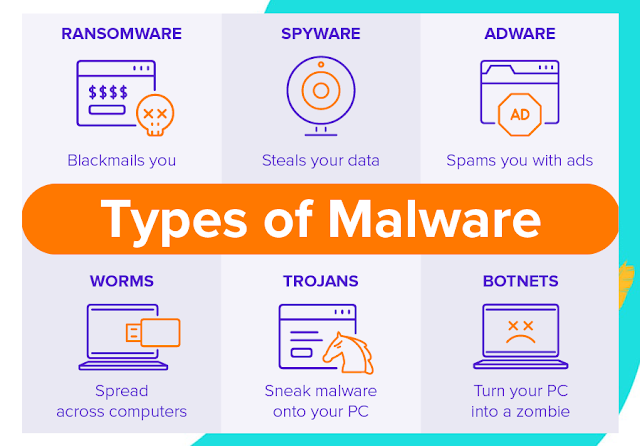Types Of Malware And How To Identify Them
Here is a guide to help you know what you are talking about with basic advice for finding and removing malware when you have been hit. People tend to lose with security terminology. However, it is vital to get your malware classifications straight because knowing how many types of malware spread, is vital to containing and eliminating them.
This incisive malware narrative will help you get your malware terms right when you hang out with tech freaks.
Viruses
Luckily, most malware programs are not viruses. A computer virus tweaks other upright host files, when a victim's file is executed, the virus is also executed.
Pure computer viruses are rare today, almost less than 10% of all malware. Viruses are the only type of malware that infects other files. That makes them exceptionally hard to finish because the malware must be killed from the legitimate program. This has always been important, and today it is almost impossible. The best antivirus programs struggle with doing it correctly and in many cases will simply separate or delete the infected file instead.
Worms
It is so grave that one person would open a worm email and the entire company would be infected in short order. The typical feature of the computer worm is that it replicates itself. Its ability to spread without end-user action makes an effective worm quite devastating. Worms exploit other files and programs to destroy. For instance, the SQL Slammer worm used a vulnerability in Microsoft SQL to provoke buffer overflows on nearly all unpatched SQL servers connected to the internet in about 10 minutes, a speed record that still stands today.
Trojans
Trojan malware programs have replaced Computer worms as the weapon of choice for hackers. A Trojan requires execution by its victim to do its work. Trojans generally arrive via email or are pushed on users when they visit infected websites. The most deceptive Trojan type is the fake antivirus program, which pops up and claims you are infected, then instructs you to run a program to clean your PC. Users swallow the jig and the Trojan takes root.
Trojans are hard to defend against for two reasons: They are easy to write and spread by tricking end-users, which a patch, firewall, and other traditional defense cannot stop. Malware writers abate Trojans by the millions each month. Antimalware vendors try their best to fight Trojans, but there are too many signatures to keep an eye on.
Hybrids And Exotic Forms
Many of today's malware programs are considered rootkits or stealth programs. Basically, malware programs try to alter the underlying operating system to take ultimate control and hide from antimalware programs. To void these types of programs, you must delete the controlling element from memory, beginning with the antimalware scan.
Bots are actually Trojan/worm combinations that attempt to make particular exploited clients a part of a larger malicious network. Botmasters have one or more ‘command and control’ servers that bot clients check into to receive their updated instructions. Botnets range in size from a few thousand compromised computers to huge networks with hundreds of thousands of systems under the control of a single botnet master. These botnets are usually rented out to other criminals who then use them for their own wicked purposes.
Ransomware
Malware programs that encode your data and hold it as hostage waiting for a cryptocurrency pay off has been a huge percentage of the malware for the last few years, and the percentage is still increasing. Most ransomware programs are Trojans, which means they must be spread through social engineering of some ilk. Once performed, most look for and encrypt users’ files instantly, although a few are now taking a “wait-and-see” outlook.
Ransomware can be averted just like every other type of malware program, but once executed, it can be hard to undo the damage without a good, validated backup. According to some studies, about a quarter of the victims pay the ransom, and of those, about 30 percent still do not get their files unlocked. Another way, unlocking the encrypted files, if even possible, takes particular tools, decryption keys and more than a bit of luck. The best solution is to make sure you have a good, offline backup of all important files.
Fileless Malware
Fileless malware, which today forms over 50 percent of all malware and is enlarging, is malware that does not quickly use files or the file system. Instead, they exploit and extend in memory only or using other “non-file” OS objects such as registry keys, APIs or scheduled tasks.
Many fileless attacks start by exploiting a current legitimate program, becoming a newly launched “sub-process,” or by using current legitimate tools built into the OS. The end result is that fileless attacks are tougher to spot and stop. If you are not already familiar with common fileless attack techniques and programs, you possibly should be if you want a career in computer security.
Adware
If you are lucky, the only malware program you have come in contact with is adware, which tries to reveal the compromised end-user to unwanted, possible malicious advertising. A common adware program might redirect a user's browser searches to look-alike web pages that held other product promotions.
Malvertising
Malvertising is the use of legitimate ads or ad networks to furtively deliver malware to unsuspecting users’ computers. When a user clicks on the ad, code in the ad either redirect them to a malicious website, or installs malware on their computer. In some cases, the malware lodged in an ad might perform eventually without any action from the user, a technique referred to as a “drive-by download.”
The goal of cybercriminals who use malvertising is to make money. Malvertising can deliver any type of money-making malware, like ransomware, crypto mining scripts or banking Trojans.
Spyware
In targeted attacks, criminals can use spyware to log the depression of a key on a keyboard of victims and gain access to passwords or intellectual property. A much bigger effect than the actual adware or spyware is the mechanism it used to exploit the computer or user, be it social engineering, unpatched software, or a dozen other root exploit causes. This is because although a spyware or adware program’s goals are not as malicious as said, a backdoor remote access trojan, they both use the same methods to break in.
Finding And Removing Malware
Sadly, finding and eliminating particular malware program components can be a silly task. It is easy to get it wrong and miss a component. Plus, you do not know if the malware program has changed the system in such a way that it will be impossible to make it totally trustworthy again.
Except you are well learned in malware elimination and forensics, back up the data, format the drive, and reinstall the programs and data when you find malware on a computer. Mend it well and make sure end-users know what they did wrong. That way, you get a trustworthy computer platform and move forward in the fight without any lingering risks or questions.
If you are still unable to understand the antivirus work process or face any problem again and again with your installed antivirus, then call us directly on Antivirus Tech Support Number, our experts will provide you with the proper guidance and will fix the issue for you instantly. At Antivirus Helpline Number we provide solutions for a wide range of issues pertaining to Antivirus. So, whatever the issue you face, call us anytime, our team is available 24*7 for antivirus support.
Source by https://www.247techigs.com/blogs/types-of-malware-and-how-to-identify-them




Comments
Post a Comment